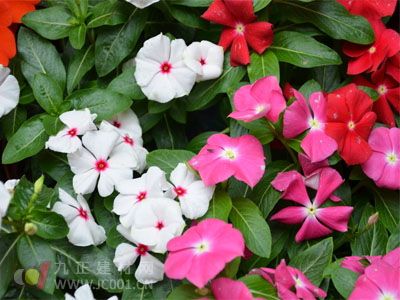Periwinkle Cultivation Management Method:
Transplanting/Upper Potting: If seedlings are grown in plug trays, they should be transplanted into a basin when they have 2 to 3 pairs of true leaves. Using a 12-centimeter nutrient pot, once the plant is placed in the pot, no further repotting is needed. If seedlings are raised in open seedling trays, it's best to transplant them once when they have 1 or 2 pairs of true leaves, and then perform a second transplant into the upper pot.
Light Regulation: Periwinkle is a sun-loving plant, and its growth and flowering require ample sunlight. Sufficient light also helps prevent leggy growth. Insufficient light during winter and low temperatures can hinder development.
Temperature Control: Periwinkle is sensitive to cold, so maintaining proper temperature is essential. In the Yangtze River region, it must be grown in a greenhouse during winter. If the temperature drops below 15°C, growth will stop, and below 5°C, the plant may freeze. However, periwinkle is more heat-tolerant and is often used in summer and holiday seasons in the Yangtze River Basin and South China.
Water and Fertilizer Management: After heavy rain, periwinkle plants are prone to damage, so areas with high rainfall should be grown in greenhouses. The growing medium needs good drainage. For full cultivation, use water-soluble fertilizers such as 20–10–20 and 14–0–14 alternately at concentrations of 200 to 250 ppm every 7 to 10 days. Reduce the use of 20–10–20 fertilizer during colder winter months. If using regular soil, mix compound fertilizer as a base before planting. If fertility is lacking, apply water-soluble fertilizer.

In addition to normal watering and fertilizing, attention should be given to managing topping and stem and leaf rot, especially during the rainy season. Topping encourages branching and controls flowering. The first topping is done when the plant has 4 to 6 true leaves (about 8 to 10 cm tall). A second topping is performed when new shoots have 4 to 6 leaves (15 to 20 days after the first topping). It’s best not to top more than three times, as too many toppings can affect flower quality.
The final topping directly affects the flowering time. Typically, the last flowering period in autumn occurs about 25 days before National Day, while the last topping in summer is 3 to 5 days earlier. Stem and leaf rot, caused by *Phytophthora*, is common in rainy seasons and can lead to significant losses. To manage this, apply 65% Trichoderma at 600–800 times dilution or 1% Bordeaux mixture before rain. If disease appears, spray 72% Metalaxyl at 600–800 times or 25% Cymoxanil at the same concentration, repeating every week for better results.
Although periwinkle is relatively easy to care for, one or two pruning sessions are necessary to achieve an attractive shape. The first pruning is done when the plant has 3 to 4 pairs of true leaves, and the second pruning removes 1 to 2 pairs of leaves from new branches. As a perennial, if the plant isn’t sold, it can be pruned again to maintain the desired height and form. Growth regulators can be used during cultivation, but paclobutrazol should be avoided.
Periwinkle Pests and Diseases
Periwinkle contains toxins, making it naturally resistant to most pests and diseases. However, during the seedling stage, issues like damping-off and gray mold may occur. Care should be taken to avoid fertilizer burn and phytotoxicity. If these problems arise, flush the plants with clean water, improve ventilation, and reduce damage. Common pests include red spider mites, aphids, and tea moths. Prolonged rain is harmful to periwinkle, increasing its susceptibility to disease. Therefore, it's important to avoid rain exposure during the growing process.
EV Charge Station,Charging station,Electric vehicle charging station,EV charging point,EV charging
Yangzhou Beyond Solar Energy Co.,Ltd. , https://www.ckbsolar.com